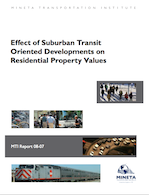- 408-924-7560
- mineta-institute@sjsu.edu
- Donate
Effect of Suburban Transit Oriented Developments on Residential Property Values
The development of successful TODs often encounters several barriers. These barriers include: a lack of inter-jurisdictional cooperation, auto-oriented design that favors park and ride lot over ridership generating uses, and community opposition. The community opposition may be more vocal in suburban areas where residents of predominately single-family neighborhoods may feel that the proposed high-density, mixed-use TOD will bring noise, air pollution, increased congestion and crime into their area. Community opposition has been instrumental in stopping many TOD projects in the San Francisco Bay Area.
While community opposition to TODs has been pronounced, very little empirical research exists that indicates whether this opposition is well-founded. Economic theory suggests that if a TOD has a negative effect on the surrounding residential neighborhoods, then that effect should lower land prices and in turn, the housing prices in these neighborhoods. Similarly, an increase in the housing prices would mean a positive effect of TODs on the surrounding neighborhoods. This study empirically estimates the impact of four San Francisco Bay Area sub-urban TODs on single-family home sale prices. The study finds that the case study suburban TODs either had no impact or had a positive impact on the surrounding single-family home sale prices.
SHISHIR MATHUR, PhD
Shishir Mathur is an associate professor in the Urban and Regional Planning Department at San Jose State University. He has a PhD (2003) in Urban Design and Planning from the University of Washington. His professional experience in planning includes work in India and the United States as a consultant, researcher, and instructor. His work in India included consulting in the fields of physical and land-use planning, infrastructure planning, and urban design. His work in the United States includes research and teaching in the fields of public finance, real estate & urban economics, affordable housing policy, land-use policy, infrastructure planning & finance, growth management, strategic planning, and systems analysis.
CHRISTOPHER FERRELL, PhD
Dr. Christopher Ferrell began his career in 1995 as a planner for the Metropolitan Transportation Commission (MTC) working on Intelligent Transportation System (ITS) applications for traffic management. He completed his doctoral studies in City and Regional Planning at the University of California at Berkeley in 2005. His studies focus on the relationships between transportation and land use and his research experience includes the evaluation of transit facilities, transportation policy analysis, transportation and land use interactions, travel behavior, and the analysis of institutional structures. As a practitioner, he has developed traffic impact studies for mixed-use, infill and transit-oriented projects, analyzed the impacts of specific and general plans and planned and implemented intelligent transportation systems, and developed bicycle and pedestrian plans. He is currently the principal investigator for TCRP H-36: Reinventing the Interstate: A 'New Paradigm' for Multimodal Transportation Facilities. He has taught several quantitative methods classes in the San Jose State University Urban Planning Department.
-
Contact Us
San José State University One Washington Square, San Jose, CA 95192 Phone: 408-924-7560 Email: mineta-institute@sjsu.edu






